Inside the primary school class with 63 pupils
- Published
- comments
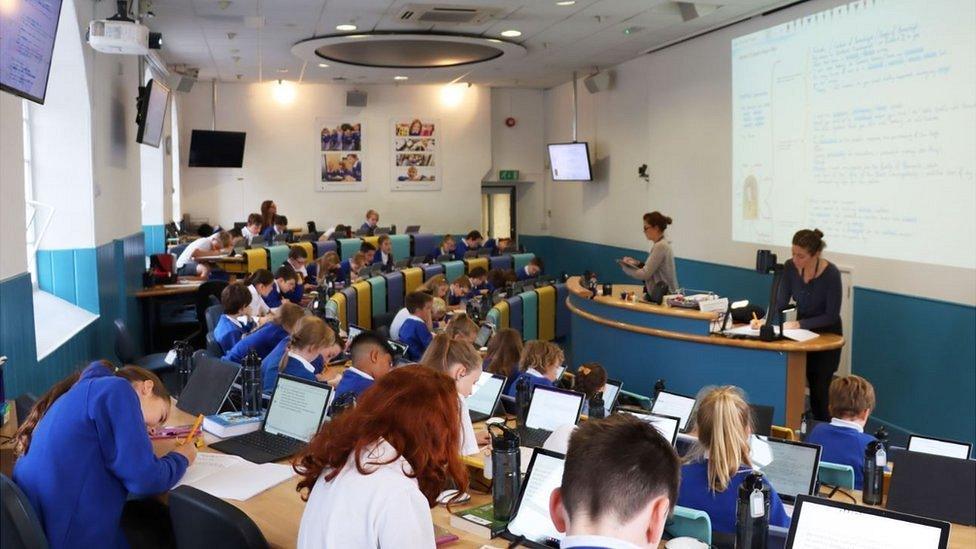
This primary school in Exeter hosts a total of 63 pupils from Year 6
A primary school was thrust into the spotlight last month when it was revealed it was teaching children in classes of more than 60 pupils. BBC News spent the day at Broadclyst Community Primary School in Devon to get a flavour of what it's like to be taught in such an environment.
"Callum. Callum. Callum."
With the help of her head-mic, teacher Bronnie Williams is carrying out the morning roll-call; the class is big enough that some name repetition is inevitable.
Standing at the front of the three-row lecture theatre, she swiftly works her way through the list of 63 pupils. Projected on the main wall behind her is an image of the children's daily tasks.
By 9am, the Year 6 children at the academy school near Exeter have spent half an hour getting on with unfinished homework or quizzes in maths and English and they're ready for classes to begin.
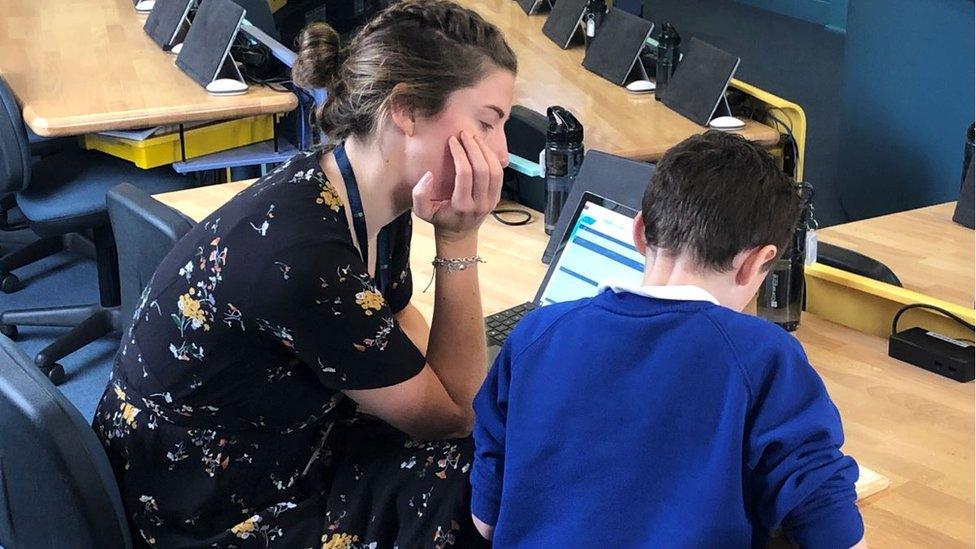
Teacher Bronnie Williams is in her fourth year at the school
Each child has an assigned seat and a £750 kit comprising a laptop computer, smart pen and mouse. The technology allows for their lessons to be uploaded to the cloud, making them accessible at any time.
The class, led by two teachers and two assistants, stays together for at least three hours a day for core lessons in maths, English and history.
For Gus, who's 10 years old, the super-sized class doesn't hold the children back. "Even though it's huge and there are a lot of us, we can all see the teacher because of the way the seats are arranged," he says. "It really allows us to socialise - that's one of the main benefits of this size."
Fellow pupil Jess, also 10 years old, is another fan.
"If you're in a class of 20 you wouldn't hear as many opinions or wouldn't have as many friends to choose from." She says all children have a mentor they see every week, who will set targets to work towards, "and if we have any problems they'll help us".

Each student has a laptop
Broadclyst's head teacher Jonathan Bishop says the lecture theatre offers a "futuristic environment fit for the 21st Century". He says 90% of his school's pupils have attained the necessary standards in writing, reading and maths - well above the 65% required by the government.
Mr Bishop firmly believes smaller class sizes aren't necessary to provide a quality education. "I think there is a simplistic historic model that says one teacher for 30 children is the correct ratio, and there is no evidence that I am aware of that says 30 children gives quality education," he says.
"Having that flexible space with the support of experienced, skilled educators to meet the needs of children is much more of a targeted approach than having a smaller class with 30 kids."
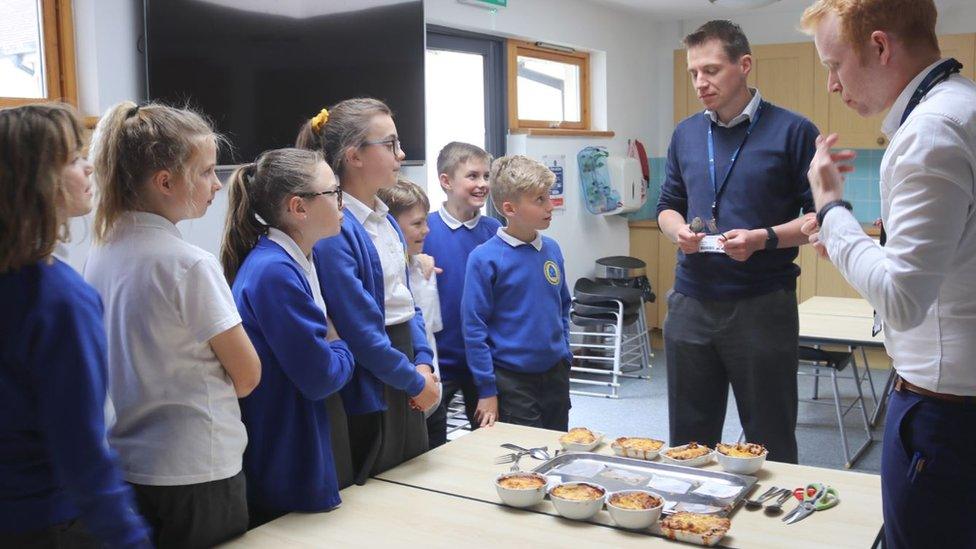
The school has been rated "outstanding" by education watchdog Ofsted
The use of technology is central to the Broadclyst approach. It hosts the Global Enterprise Challenge, external, which gives children hands-on experience of marketing, web design and accountancy. The initiative connects the village school with classes around the world, from Israel and the Dominican Republic to Jordan and Spain, through cameras hanging from each corner of the lecture theatre.
"It's really good that we've got access to this amount of technology as it allows us to hear lots of different opinions and see lots of different things," Gus says.
The "super-sized" class is led by two teachers and two assistants
After the core lessons, the class breaks up into groups of no bigger than 15. While keeping order might sound like an impossible task in a class of 63, the pupils' movements seem almost choreographed, with their smooth and snakelike exit being a spectacle in itself.
Now they're in smaller groups, the children go on to lessons in science, art and music. PE classes range from sailing and mountain biking to climbing, football and dance.

The Year 6 class breaks out into smaller groups for lessons in art, music and PE
The government has enforced, with a few exceptions, a limit of 30 pupils to one teacher in infant classes, but there is no cap for older children.
Unions advocate for the 30:1 ratio to be extended to all classes regardless of pupils' age, as they believe a smaller class size has a "powerful impact on pupils' educational experiences", and they also say there are health and safety concerns relating to larger classes.
You might also be interested in:
The National Education Union's South West representative Hannah Packham told the BBC it was "extremely shocking and disturbing" to hear of the 63-strong class.
"Teachers in class sizes that are manageable are able to pick up some of the smaller issues that are difficult to highlight in a child," she says. "The ability to provide that pastoral support in a class of over 30, even arguably over 25, is really difficult."
She says she fears there could be an increasing number of schools introducing larger class sizes, even when teachers might "feel very uncomfortable" with this.

The classes outside the lecture theatre are capped at 15 pupils
Asked whether his school had introduced the large class for financial reasons, Mr Bishop's response is that "this is not about money".
"This is about the delivery of great education," he says. "They're sitting in a hi-tech, futuristic room with four adults in that room. So you could take a traditional classroom and have one teacher and 30 children and it would be cheaper than what we are delivering here in this room."
Miss Williams, the main teacher in Broadclyst's Year 6, says class size does little to affect the teachers' workload. What has "really made a difference" for her has been the streamlining of tasks such as planning and marking.
Outlining the benefits of working with another three adults, she says: "Because you're team-teaching you're able to embellish and add upon the other person's input during the teaching and support each other."
She adds: "It [class size] definitely hasn't affected the support that we can give to children.
"It's my fourth year and I really enjoy it; I actually can't imagine going back to teaching a different way."

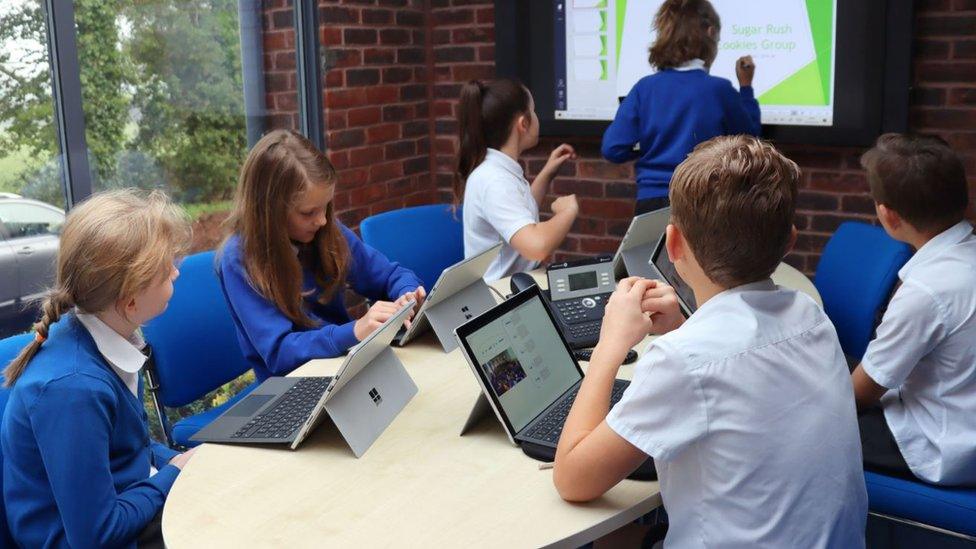
What does the research say?
A link has been found between smaller classes and attainment during the early years of school, but that appears to be less the case as pupils get older, a Department for Education report, external states.
According to the Education Endowment Foundation,, external while reducing class sizes can indeed help children, this is only the case when pupil numbers are below 20 or even 15.
Dr Stephen Curran, a teacher for 35 years and a government adviser, argues that bigger classes can be "extremely good" in schools where resources are used "wisely and effectively".
"This sort of rigid idea of having 30 in a class and that's the only unit you can ever teach, that doesn't really make sense to me." He believes technology can free teachers of the more tedious tasks so they can "use their expertise in the most efficient way".

- Published20 February 2019
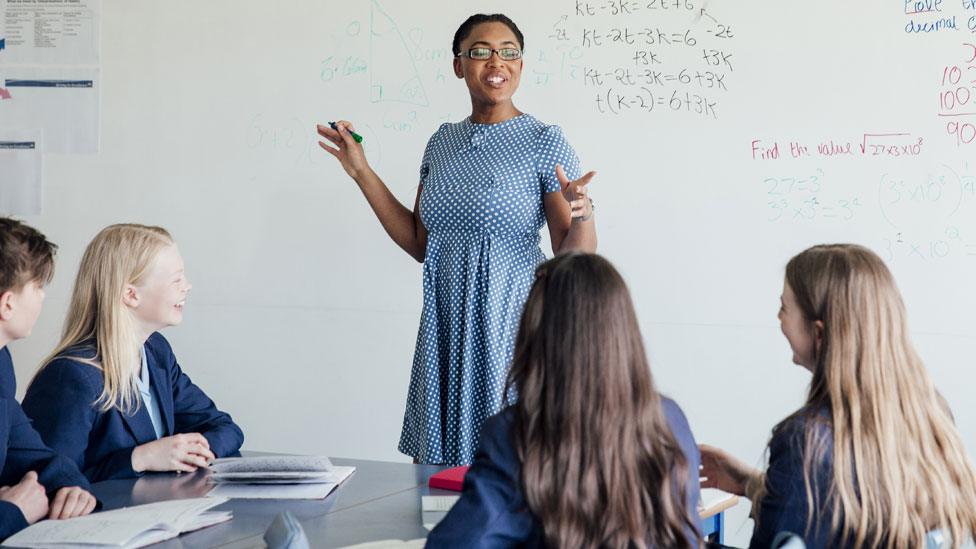
- Published8 March 2018
